Why CEOs Need to Think like a CIO in 2022 (and Beyond)
Customer satisfaction is the primary goal of every retailer. But now we’re in a new norm, and the way you achieve this is changing rapidly.
Fewer people are shopping in-store. More folks are ordering online. The demand for goods is rising and what customers value is changing. Keeping up with it all requires a massive ongoing collection and analysis of customer data to make strategic moves that attract and retain customers.
This is possible using AI-powered technology. But which should you choose?
You’re a CEO with in-depth knowledge of the grocery industry. This gives you the advantage to outsmart retail tech competitors.
Unfortunately, you don’t have a deep understanding of today’s tech or how to think like a CIO. How you choose a solution today is different from several years ago. It’s not just about addressing problems—it’s about adding value to your customers.
This requires a more strategic approach to digital transformation, and it shines a light on the importance of the CIOs role (and their way of thinking).
But before we dive into that, let’s review emerging trends impacting today’s grocers.
Post-pandemic trends impacting grocers
Roughly 75% of people shopping online for the first time say they’ll continue to do so even after things return to “normal.”
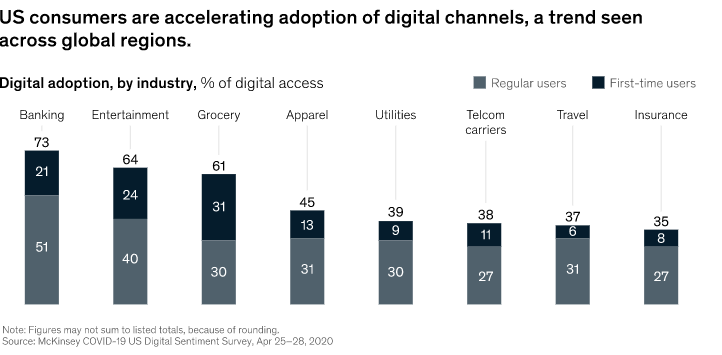
Source: McKinsey
However, it’s not just younger generations you have to cater to. Numbers show baby boomers are moving online to purchase from retailers.
“There has been a significant increase in consumers over 50 who had never shopped online and are now saying, ‘Oh wow, this is so much easier than I thought.” — Deborah Weinswig, Chief Executive at Coresight Research.
For perspective, those 65 and older spent an average of $1,615 online during the first three quarters of 2020. Plus, there are other consumer purchasing habits evolving.
According to Deloitte Insights, consumers are shopping less frequently in-store—54% say it stresses them out. Plus, there’s a surge in buying in bulk, leading to more stockouts.
What do you think happens when customers can’t find what they need? Odds are, they’ll either buy from a different brand or shop with another retailer entirely.
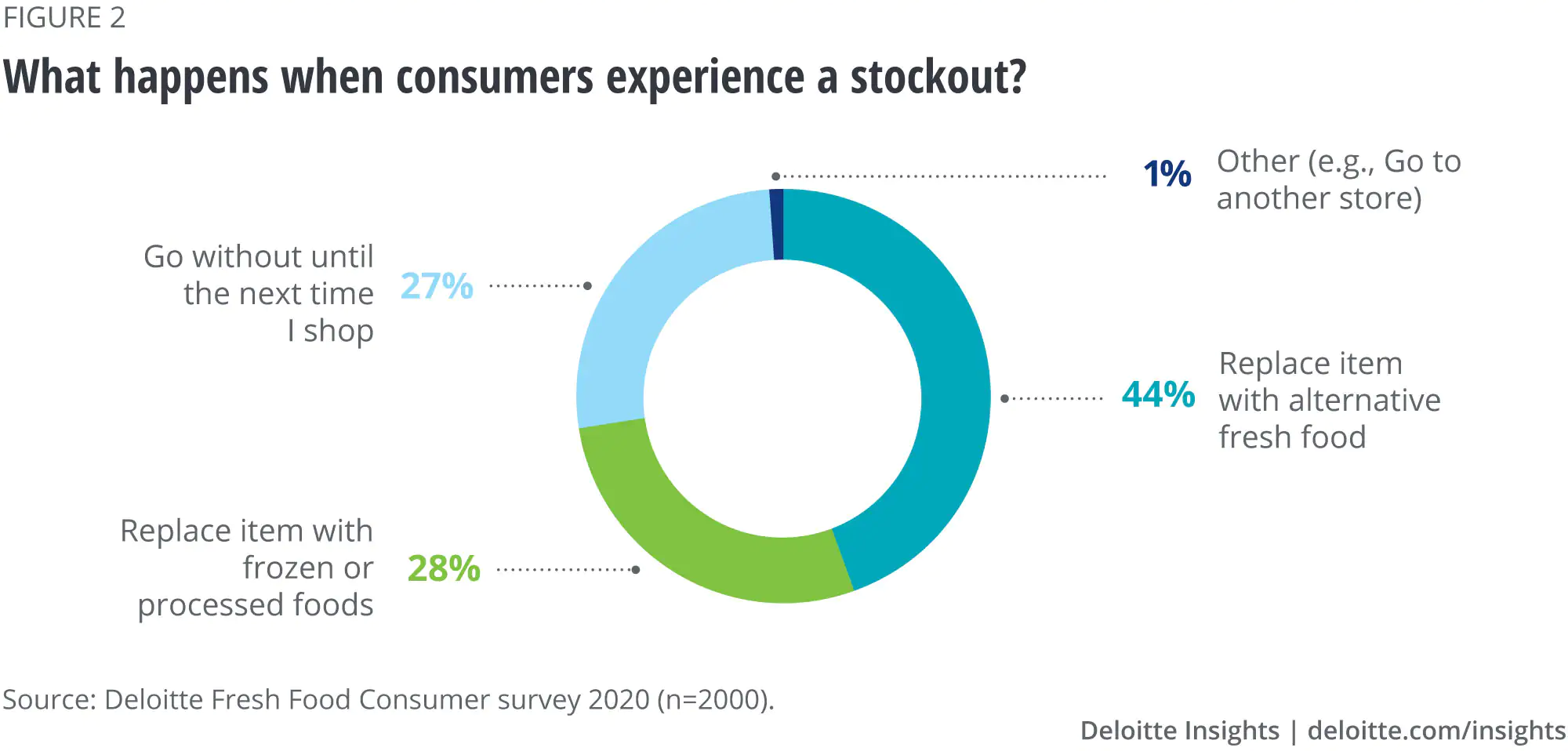
Source: Deloitte
Then there’s the issue with changing values. An astounding 90% of consumers say safety is equal to price when considering a purchase. Not just for in-store shopping, but regarding the production of the food packaging used. People want safety for themselves and those who manufacture it.
Deloitte also points out two prominent personas emerging:
- Contemporary consumers (younger omnichannel shoppers loyal to categories and desire fresh foods)
- Conventional shoppers (older, rural, lower-income shoppers)
So when you analyze these trends, you’ll see four hurdles to overcome:
- Fewer in-store shoppers, leading to increased online orders and stockouts
- New digital converts (most of which are older)
- Unhappy customers switching to competitors due to stockouts or poor online UX
- Disruption in customer loyalty
The solution: adopting better technologies and strategies. For example, building eCommerce solutions that are user-friendly (even for seniors), and employing AI to analyze large volumes of consumer data to improve CX and meet changing customer demands.
If you don’t move quickly, your competitors will sideline you, making it tougher to carve your piece of the eCommerce pie.
So it’s critical to work together with your CIO to develop a sound strategy that caters to both your business and its customers.
“CEOs rely more on CIOs to craft the innovation and future of their companies—some bringing fresh talent and perspective from outside the industry. CIOs are instrumental in driving strategically important technology and digital transformation programs for the businesses,” says Orlee Tal, CEO of stor.ai.
On that note, let’s inspect the rise of technology and the CIO’s role post-pandemic.
Technology and CIOs: A new horizon for grocery retailers
Consumers today aren’t moving online—they’re already online. It’s an ideal time for grocers to spearhead retail tech companies using their wisdom.
Tech companies like Shipt, Instacart, and Gorillas entered the grocery industry as apps, not grocery experts. So their approach is from a technological front. As a grocer, combining your industry expertise with a CIO mindset can create higher customer retention levels and loyalty.
“CEOs, in many grocery chains, grew in the grocery business during a time when being a brilliant merchant was a primary skillset, not technology. Since technology is a major driver for innovation and for remaining relevant in the market, that has to change.” — Orlee Tal
Also, many grocers are doing just that. Some examples of existing technologies grocers adopted:
- Self-checkouts to make the in-store experience for employees and shoppers (saw a 25% surge in 2020)
- Online shopping to cater to adapt to the changing buying habits of consumers
- Loyalty programs to promote retention and loyalty
While this is a brilliant move for grocers, it’s not a cure-all for their current challenges. Take, for example, Instacart. It’s a solution retailers use to offer pickup services to customers. Yet, if you look at online reviews, you’ll find customers lamenting about long wait times and flubbed delivery orders.
It’s an issue Woolworth, an Australian grocer, faced recently after implementing its own set of technologies.
“From a pure technology perspective, it was not too much of a challenge in that I think we could ramp up from a tech infrastructure capacity capability. I think enabling our team has been more of a challenge, particularly around online in terms of pure volumes.The technology could take 10 times, 20 times more orders, but to fulfill those orders has been a challenge, so we’ve had to think on our feet in the way we ramp up our picking capability.” — John Hunt, CIO at Woolworth
So it’s not just a technology “thing.” These are issues a grocery CEO anticipates with the help of HR. Then partnering with the CIO to select a better solution to negate these issues before (or when) they arise.
Together, CIOs and CEOs can make faster decisions and remain agile in the highly competitive retail space. It’s also why many CEOs believe CIOs will be the most critical executives over the next few years.
“CIOs have to help the company think about what’s coming and be knowledgeable about what’s happening in the tech world. They’re the ones who have to help educate the rest of the leaders. The CIO’s job is to bring the organization forward to be innovative and forward-thinking.” — Theresa Drew, board member of Cato Corporation and Sonoco Products
Because of the growing need for CIOs to shape and execute business strategy, it’s critical that they have more than tech knowledge. They need strong business acumen, alongside the ability to deploy new technologies.
Kathryn Guarini, IBM CIO, explains that chief information officers are key to breaking down silos in the organization and creating new value streams. They’re the connectors throughout the business and engage with the CEO to incorporate technology strategies that promote efficiency, agility, and business growth.
Some even speculate that CIOs should go beyond technology and aligning with the business—they need to be drivers of change. Thinking outside the box and innovating are critical for the grocers of tomorrow.
This is why more retailers place their CIOs at the forefront of business decisions. For example, Kroger empowered its CIO, Christopher Hjelm, to develop it into a technology company. He was behind some of its industry-leading solutions like Scan, Bag, Go; ClickList, QueVision (Kroger’s solution to hasten checkout times), and Edge Shelf digital technology.
Some even sit in high positions, like Whole Foods’ CIO, Jason Buechel, who went from Global Vice President to Chief Operation Officer. He oversees operations of all stores and facilities, as well as the technology, supply chain, distribution, and Team Member Services.
The mission of tomorrow’s CIO is to create better customer experiences. Trader Joe’s CIO knows this, which is why he said don’t ask him about digital transformation, instead:
“Ask me, ‘How am I helping my business to deliver wow customer experiences, have amazing products in the stores at the lowest possible cost, give our crew members what they need to engage in really awesome experiences and relationships with their customers?”
Why CEOs need to think like a CIO
Thinking like a CIO doesn’t mean taking over the role of your chief information officer. It’s about eliminating the challenges they each day. When a CEO thinks like a CIO, it’s a lot easier to convince them to adopt new technology.
In the retail industry, technology is fast-moving and requires constant adaptation to stay ahead of the competition. So by being a tech-savvy CEO, you make it easier for your CIO to get approval from the C-suite and fast-track technology implementation.
Anne Nørklit Lønborg, CIO of Tryg explained the ideal CEO-CIO dynamic perfectly:
“We are both driving and enabling; we call it yin and yang. The business is pulling us forward, but we’re also starting to push technology opportunities to the business in order to influence the business and its strategy. We’re trying to improve the IT organization to be proactive and positioned as a business unit instead of being a reactive staff function and pulled by the organization, but it’s a constant back and forth.”
The CIO mindset also empowers CEOs to run a company that’s agile, scalable, and innovative, which is critical in our growingly digitized world.
Plus, it’s becoming apparent—one study shows CEOs and tech leaders align on the importance of technology in driving business strategy and performance.
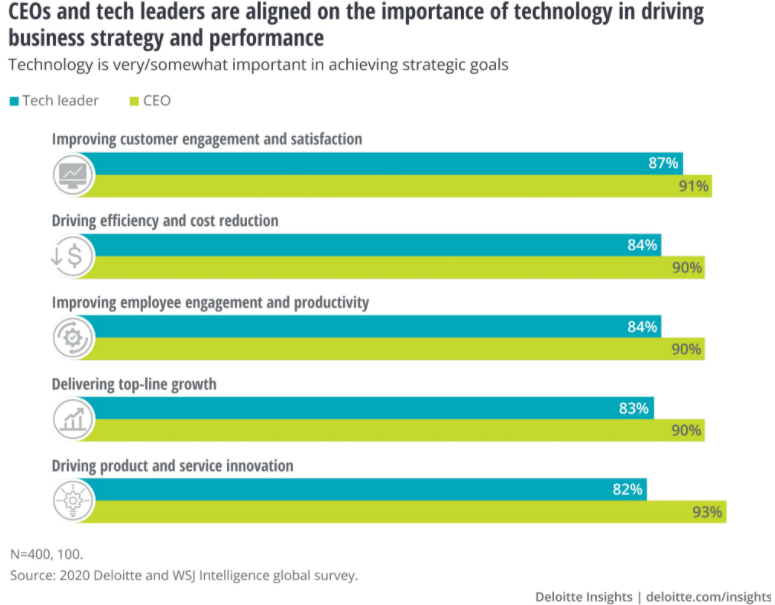
Source: Deloitte
The study also reveals high-performing companies are 2.5x more likely to make technology a leading focus to execute business goals. Their IT functions are also 3x more likely to be responsive in leveraging emerging technologies.
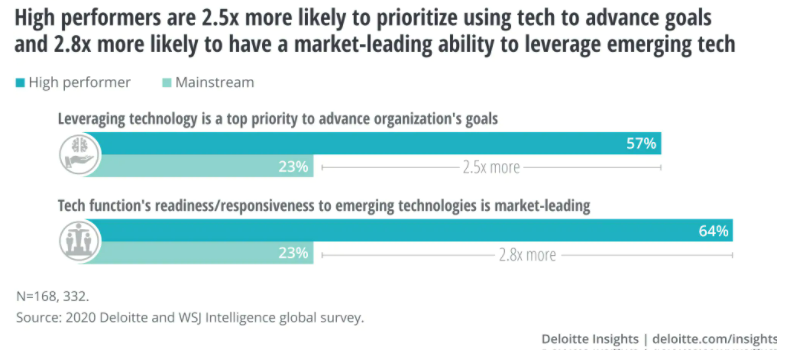
Source: Deloitte
“The role of a technology leader is not to develop a digital strategy or vision—it is to embed digital in the business strategy. — Larry Quinlan, global CIO of Deloitte.
This logic is quickly spreading, with 40% of CEOs stating their tech leaders are key drivers of business strategy. CIOs are becoming primary partners in driving forward business strategy.
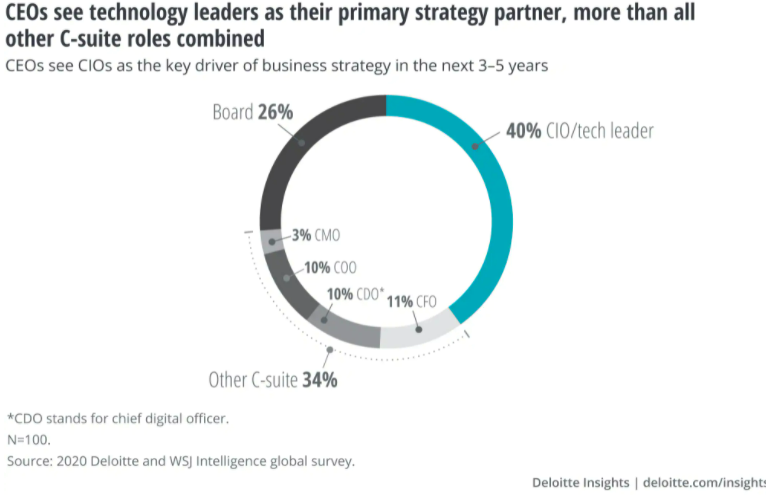
Source: Deloitte
This shift is happening across industries. For instance, in grocery, we see Albertsons focusing on modernizing its tech. They’re investing more in technology to enhance efficiency and improve results. This includes updating old systems. In doing so, they saw a 1.5% YoY increase in same-store sales in Q2 2021. And a 15.3% increase from the same period in 2019.
There’s no doubt that partnering with CIOs is an effective business move. The question now is how do retail CEOs lead the charge in developing a CIO mindset that drives growth?
How CEO’s can think like a CIO
A CIO is a business leader with rich insights about IT and how it connects with the business and its vendors and customers. They’re in-the-know about business objectives and how to achieve them using an IT strategy, roadmap, and solutions.
Yet, their role only prevails when the CEO views the CIO as an enabler, not an afterthought. Here are 5 tips to make thinking like a CIO second nature.
1. Recruit a CIO who’s at forefront of technology
A reactive CIO doesn’t offer the same impact as one that’s proactively looking for emerging technologies to implement. By hiring a CIO that’s abreast of the latest technological trends, you can ensure you’re always ahead of competitors.
Keeping up with all the latest technologies and tech startups is a full-time job of its own. As a CEO, it’s an impossible task. Instead, enlist the help of your CIO who’s always at the forefront of emerging tech.
With their help, you can build short-term and long-term strategies using technology to support your business objectives.
“For the CEO, I think its mission critical to be aware of how new capabilities can advance the company, whether through improved customer experience or operations. CEOs obviously have other full-time responsibilities, so my suggestion would be to focus on understanding the potential of innovation along with watching and understanding what their competitors, especially digital native competitors, are doing.” — Gary Hawkins, CEO of Center for Advancing Retail & Technology
2. Bring your CIO to the decision table
CIOs have a unique perspective on what matters most to the business. They understand the impact of new technologies, trends, and regulations, but only if you bring them into the conversation.
Inviting tech leaders to strategy meetings empowers them with the information they need to advise the company from a technology angle. It also allows the C-suite to better understand the “why” and “how” of the CIO’s recommendations, providing quicker buy-in.
“[When tech is core to business strategy] the CIO [is] at the table with the CEO defining new business models and new ways of working with data, tech, digital and cloud at the core of the strategy, not as an afterthought.” — Dan Priest, Cloud and Digital Managing Partner at Global Consultancy PwC of London.
3. Approach tech decisions the same way you do business decisions
Purchasing a software solution. Deciding to open a new warehouse. These are strategic actions that impact the business. So approaching tech buying as you do any other business decision is critical.
Making the wrong choice can turn an investment into a margin killer. Much like opening a new store in the wrong location can eat up your revenue and hurt profits.
The same goes for deciding whether to keep or chuck software. Keeping or letting go of the wrong tools can hurt revenue, retention, and productivity. A part of thinking like a CIO is using available resources to stay ahead of the curve.
Consider subscribing to newsletters and podcasts that discuss the latest retail technologies. Gary Hawkins vouches for this approach and even offers a resource, Retail 4.0: The Age of Metamorphosis, that educates retail industry executives about key future technologies that’ll transform and disrupt the industry.
However, he takes it a step further:
“Read and listen to podcasts focused on new technology and innovation, but that may be outside grocery-specific publications. Confining reading to grocery industry publications, newsletters, etc., limits you to the same news being circulated around. By reading outside grocery retail, CEOs can gain a broader understanding of technology trends they can then bring back to their organizations.” – Gary Hawkins, CEO of Center for Advancing Retail & Technology
4. Think far and wide
When considering new technology, determine how it’s going to contribute to your organization and its goals. Will it assist with overcoming current issues, as well as potential problems that may arise? Who will benefit from its usage?
Thinking long-term enables you to plan proactively vs. reacting to today’s roadblocks. Then, considering the needs of employees across departments ensures they’re getting the tools needed to make them more efficient.
For example, if you offer curbside pickup services, then buying an AI eCommerce software with a picking solution is a smart move. It reduces cashier workloads and helps pickers quickly find products and alternatives.
The solution can even help with long-term goals for customer retention, since it enhances CX and satisfaction rates.
5. Take a customer-centric approach
Happy customers are loyal buyers. So the software you buy should enhance their experience with your store (online and offline).
“As the customer experience is being digitized and users feel more comfortable with technology, there should be a shift to operating the digital aspects of the in-store and the online experience. To create a seamless and comprehensive customer journey, the CEO, CMO, and eCommerce manager need the support of CIOs that welcomes innovation.” — Orlee Tal
For instance, stor.ai is an AI-powered customer-first commerce platform designed specifically for grocers. It’s a white-label eCommerce solution with digital merchandising, marketing automation, and order picking and fulfillment capabilities.
Having an end-to-end solution simplifies the roles of multiple departments, enhances customer experiences, and promotes revenue generation. If you’d like to learn more about our solution, then book a demo with us today.
